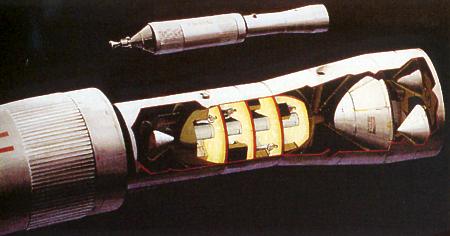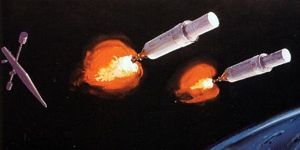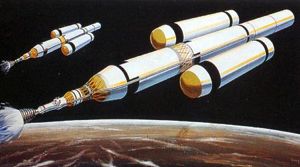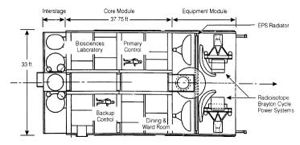
Home - Search - Browse - Alphabetic Index: 0- 1- 2- 3- 4- 5- 6- 7- 8- 9
A- B- C- D- E- F- G- H- I- J- K- L- M- N- O- P- Q- R- S- T- U- V- W- X- Y- Z
Von Braun Mars Expedition - 1969

MEM
Credit: NASA
Status: Study 1969. Thrust: 1,733.80 kN (389,774 lbf). Gross mass: 726,000 kg (1,600,000 lb). Unfuelled mass: 182,000 kg (401,000 lb). Specific impulse: 850 s. Height: 82.00 m (269.00 ft). Diameter: 10.06 m (33.00 ft).
They were entirely reusable for future expeditions, the only element being expendable being the Mars Excursion Module used to visit the planet's surface. This was Von Braun's last attempt to convince the American government to finance his dream. Five months later he would be sidelined to a dead-end headquarters job at NASA, and leave the Agency two years after that.
The successful landing on the moon of Apollo 11 brought a brief period of political enthusiasm for manned spaceflight. A new Space Task Group was formed to recommend a post-Apollo manned space program. On 4 August 1969 NASA Administrator Paine briefed the Space Task Group, with Vice President Agnew chairing, on Marshall's proposed post-Apollo integrated plan. Von Braun briefed the plan for a manned expedition to Mars as a follow-on to Apollo. The Integrated Plan foresaw first flight of a manned space shuttle by 1975, an earth orbit space station soon thereafter, with production and improvement of the Saturn V continuing, and the NERVA nuclear thermal upper stage completing development. All of these projects would mean a Mars spacecraft like that proposed by Boeing in 1969 could be developed, with the only new unique hardware being the Mars Excursion Module (the Mission Module would be one of the modules already proven on the earth orbit station). Testing in earth orbit of the first Mars Excursion Module would begin in 1978, with the first Mars landing coming in 1982.
Von Braun had tweaked his original Mars Expedition scenario between 1952 and 1956 to halve the size of his original Mars expedition spacecraft. He used the same methods in 1969 to come up with Mars spacecraft under half the mass of Boeing's 1968 IMIS. This allowed two Mars expedition spacecraft to travel in convoy on the mission together, providing Von Braun's preferred mutual support and back-up. The Nuclear Shuttles used for propulsion were essentially the same as Boeing's Primary Propulsion Modules, and had 38 metric tons less propellant. But due to lower delta-V's at Mars orbit, only three of the NERVA Primary Propulsion Modules (now called Nuclear Shuttles) were needed per spacecraft as opposed to five in Boeing's study. The spacecraft consists, from fore to aft:
- Two lateral PPM's. These were only partially fuelled, enough for the necessary delta-V to set the spacecraft toward Mars on 12 November 1981. They then separated, and maneuvered back to rendezvous and docking with the earth orbit station. There they were refueled and reused for earth-moon shuttle service or a future Mars expedition.
- A central PPM. This provided all of the remaining delta-V for the mission - insertion into Mars orbit, trans-Earth injection, and a braking maneuver back into earth orbit at the end of the mission. Significant savings were obtained by braking into and leaving a high-altitude elliptical Mars orbit rather than a low-altitude circular orbit.
- A Planetary Mission Module. This was the result of Phase B studies to identify a module that could be used for both earth and lunar space stations and interplanetary flights. It provided six crew with quarters during the mission. It had sufficient consumables that 12 crew could be supported in case one of the spacecraft had to be abandoned anywhere along the route.
- Mars Excursion Module. The variation for this mission had a mass of 43 metric tons. It could descend from the high elliptical orbit, and support three crew on the surface for up to sixty days. Since two ships were in convoy, the two MEM's could land near each other and provide mutual support. All six surface crew could return in one of the MEM's ascent stages if needed.
- 16 unmanned probes. 12 would return samples from various sites on the Martian surface to the orbiting PMM. Four would be dropped into the atmosphere of Venus during the swingby of that planet on the return home.
The mission profile was as follows:
- 12 November 1981: Trans-Mars injection. Each spacecraft had a starting mass in low earth orbit of 727 metric tons. After the 3.8 m/s maneuver, the two lateral PPM's would separate, leaving the single PPM, PMM, MEM, and probes with a total mass of 614 metric tons.
- 9 August 1982: Mars orbit insertion. The spacecraft entered an elliptical Mars orbit. This requires a delta-V of only 2.2 km/s, only 1/3 to 1/8 the amount Boeing assumed in their study for obtaining a circular orbit. This was a huge driver in reducing the total expedition mass. Mass before the maneuver was 295 metric tons, and afterwards around 226 metric tons.
- The MEM's separate and headed for the surface. Meanwhile, the three crew left aboard each PMM drop the 12 sample-return probes and survey the Martian surface and moons from orbit.
- 28 October 1982: Trans-Earth Injection. Having shed the MEM and probes, the mass at the start of the maneuver was 172 metric tons.
- 28 February 1983: Venus swingby. This reduces the velocity at the return to earth, and provided an additional science opportunity. Four probes were dropped into the atmosphere of Venus.
- 14 August 1983: Earth Orbit Insertion. The PPM fired one last time to brake the spacecraft into low earth orbit. It docked with the earth orbiting space station and the crews and their samples were placed in quarantine. Final mass of each ship was 72.6 metric tons. Von Braun preferred this approach to a direct return to earth in an Apollo Command Module. His mission profile made the propellant available for it, and the risk of contamination of the earth by Martian organisms was eliminated.
The Space Task Group made its final report on 15 September 1969, recommending the whole vast infrastructure envisioned by Von Braun. It was not to be -- every element of the NASA plan, except for a much-compromised space shuttle design, would be stripped away by Nixon's budget office. There was no public support for such a grand scheme. The view of Mars as a seemingly barren, lifeless, and uninteresting world in any case was reinforced by the Mariner 7 mission which flew by the planet the day after Von Braun's presentation was made. His ultimate dream crushed, Von Braun was sidelined to a headquarters post at NASA seven months later. He left NASA in 1972 and died in 1977.
Von Braun Mars Expedition - 1969 Mission Summary:
- Summary: Final NASA/Von Braun design for a manned expedition to Mars using nuclear thermal rockets.
- Propulsion: Nuclear thermal
- Braking at Mars: propulsive
- Mission Type: opposition
- Venus swingby: yes
- Split or All-Up: all up
- ISRU: no ISRU
- Launch Year: 1981
- Crew: 12
- Mars Surface payload-metric tons: 5
- Outbound time-days: 270
- Mars Stay Time-days: 80
- Return Time-days: 290
- Total Mission Time-days: 640
- Total Payload Required in Low Earth Orbit-metric tons: 1452
- Total Propellant Required-metric tons: 1088
- Propellant Fraction: 0.74
- Mass per crew-metric tons: 121
- Launch Vehicle Payload to LEO-metric tons: 249
- Number of Launches Required to Assemble Payload in Low Earth Orbit: 6
- Launch Vehicle: Saturn V-25(S)U
Family: Mars Expeditions. People: von Braun. Country: USA. Engines: Nerva-1. Spacecraft: MEM, PPM, Planetary Mission Module. Propellants: Nuclear/LH2. Bibliography: 49, 591.
 | Mars 69 Credit: NASA |
 | Mars 69 Credit: NASA |
 | Mars 1969 MM Credit: NASA |
1966 April 15 - .
- NASA new manned space flight goal not using Apollo hardware - .
Nation: USA.
Related Persons: Gilruth,
Mueller.
Spacecraft: IMIS 1968,
Von Braun Mars Expedition - 1969.
NASA said to need a manned space flight goal other than "using Apollo hardware" - a Mars flyby or landing mission. MSC Director Robert R. Gilruth summarized Houston's position expressed during discussions with Associate Administrator for Manned Space Flight George E. Mueller two days earlier. Gilruth cited NASA s need for a manned space flight goal other than 'using Apollo hardware' (and suggested a Mars flyby or landing mission as an in-house focus for planning.) Also, he repeated his concern over the imbalance between AAP goals and resources, as well as the extent of engineering redesign and hardware modification that had been forced upon the project. Though expressing his and MSC's desire to contribute to and be a part of AAP, Gilruth voiced concern that 'the future of manned space flight . . . is in jeopardy because we do not have firm goals, and because the present approach appears to us to be technically unsound.'
Back to top of page
Home - Search - Browse - Alphabetic Index: 0- 1- 2- 3- 4- 5- 6- 7- 8- 9
A- B- C- D- E- F- G- H- I- J- K- L- M- N- O- P- Q- R- S- T- U- V- W- X- Y- Z
© 1997-2019 Mark Wade - Contact
© / Conditions for Use